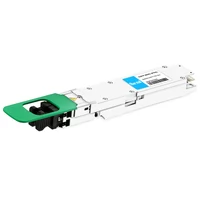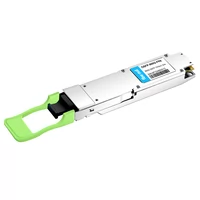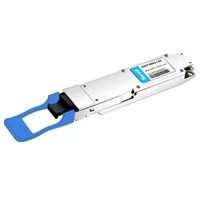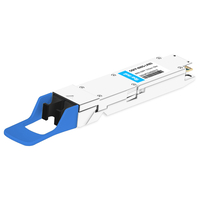With the development of innovative technologies such as Super Ethernet and high-speed data centers, the network industry’s demand for faster, more efficient and scalable solutions has also grown rapidly. Against this backdrop, 800G Ethernet has emerged as a transformative technology that can significantly increase bandwidth and improve energy efficiency. It will revolutionize communication networks and support cutting-edge applications such as machine learning and cloud services. This article takes an in-depth look at how 800G Ethernet supports future-oriented scalability and lays the foundation for the future hyper-connected world.
What is 800G Ethernet?
800G Ethernet is a high-speed network technology designed to meet the needs of modern communications, with a data transmission rate of an astonishing 800 gigabits per second (800Gbps). This speed is twice that of the previous generation 400G Ethernet, providing strong support for data centers, cloud services and high-bandwidth applications.
It runs through 8 channels, with each channel transmitting at a rate of 100Gbps, which doubles the transmission speed compared to the 50Gbps per channel of the previous generation PAM4 signal. This high-speed transmission capability enables 800G Ethernet to achieve higher throughput and better network performance in large-scale data centers and cloud environments, making data communications faster and more efficient.
The implementation of 800G Ethernet relies on advanced network hardware and optical modules that not only support high-speed data transmission, but also adopt low-power design to improve energy efficiency. The Institute of Electrical and Electronics Engineers (IEEE) is responsible for the standardization of 800G Ethernet to ensure seamless interoperability between equipment from different vendors. This standardization process is critical to building a unified and efficient global network. The process enables 800G Ethernet to realize its maximum potential in different application scenarios.
Advantages of 800G Ethernet
800G Ethernet represents a major leap forward, providing the high bandwidth, low latency, and scalability required to support next-generation workloads. The following are the key benefits of 800G Ethernet in today’s rapidly evolving technology environment:
- Ultra-high bandwidth: 800G Ethernet provides a transmission rate of up to 800Gbps, which is twice that of 400G Ethernet. This ultra-high bandwidth can easily cope with the transmission needs of large-scale data sets, which is particularly suitable for scenarios such as artificial intelligence training, high-performance computing (HPC), real-time data analysis, and large-scale storage. For example, AI model training usually requires processing TB-level data in a short period of time. 800G Ethernet is ideal for AI training because it can significantly shorten data transmission time and improve computing efficiency.
- Low latency: 800G Ethernet combines advanced network technologies such as RoCEv2 (RDMA over Converged Ethernet) and Priority Flow Control (PFC) to significantly reduce network latency. RoCEv2 implements remote direct memory access (RDMA) over Ethernet, bypassing the CPU’s processing overhead to achieve ultra-low latency data transmission. This is critical for time-sensitive applications such as autonomous driving, financial transactions, and real-time AI reasoning, ensuring fast data processing and response.
- High scalability: 800G Ethernet is designed to be highly scalable and can support the dynamic expansion of data centers and future technology upgrades. Its modular architecture allows enterprises to gradually expand network capacity without replacing core equipment to adapt to growing business needs. This scalability not only reduces the initial investment cost of the enterprise, but also ensures the continued availability of the network infrastructure for many years to come.
- Open standards and interoperability: 800G Ethernet is based on open network standards and supports seamless interoperability between equipment from different suppliers. Compared with proprietary networks (such as InfiniBand), this openness reduces the risk of vendor lock-in and enables enterprises to flexibly choose the hardware and software that best suits their needs. At the same time, open standards also promote technological innovation and market competition, further reducing costs.
- Cost-effectiveness: Although the initial investment of 800G Ethernet may be higher, it can significantly reduce the total cost of ownership (TCO) in the long run. By leveraging open standards and commercial components, 800G Ethernet reduces hardware procurement costs and maintenance expenses. In addition, its high bandwidth and low latency characteristics can improve the operating efficiency of data centers, reduce energy consumption and operating costs, and thus bring higher return on investment (ROI) to enterprises.
- Powerful network management and automation: 800G Ethernet supports advanced network management functions, such as software-defined networking (SDN). SDN technology allows network administrators to optimize network resource allocation through centralized control and dynamic configuration, improving network flexibility and responsiveness. In addition, 800G Ethernet can also be combined with AI technology to achieve intelligent network optimization and fault prediction, further improving network reliability and performance.
- Future-oriented compatibility: 800G Ethernet not only meets the current high-performance computing needs, but also provides support for future technological development. For example, it can seamlessly connect to next-generation network technologies (such as 1.6Tbps Ethernet) and emerging applications (such as quantum computing and edge computing). This forward-looking design ensures that enterprises do not need to replace existing infrastructure on a large scale when upgrading technology, reducing future upgrade costs.
- Enhanced security: As data transmission speeds increase, network security risks also increase accordingly. 800G Ethernet protects the security of data transmission by integrating advanced security technologies such as end-to-end encryption, zero-trust architecture, and real-time network monitoring. These measures can effectively prevent data leakage and cyber attacks, ensuring the security of sensitive information, especially when processing artificial intelligence training data and critical business applications.
- Support for green data centers: 800G Ethernet is designed with energy efficiency optimization in mind. By using efficient chip technology and advanced cooling solutions, 800G devices are able to reduce energy consumption while delivering high bandwidth. This is critical to building green data centers, especially as the world’s attention to sustainable development continues to grow.
- Simplified network architecture: 800G Ethernet can integrate multiple low-speed links into a single high-speed link, thereby simplifying the network architecture. This integration not only reduces the complexity of wiring and the number of devices, but also reduces the difficulty and cost of network management. At the same time, the simplified network architecture also improves the reliability and maintainability of the system.
800G Ethernet: A Solution to Meet Massive Data Demands
With the rapid development of artificial intelligence and machine learning technologies, the amount of data has exploded. Taking the training of large artificial intelligence models as an example, from GPT-1 to GPT-4, the number of model parameters has skyrocketed from 110 million to 500 billion, and is expected to exceed one trillion in the near future. Such a huge amount of data places extremely high demands on the transmission capacity of the network. Research institution Trend Force pointed out that the GPT-3.5 large model requires 20,000 GPUs to use NVIDIA’s A100 graphics card to process training data. In this case, it is difficult for the traditional network technology to meet the needs, and 800G Ethernet has become an ideal choice for meeting this challenge with its ultra-high bandwidth and transmission speed.
In the supercomputing center of a large computing cluster, computing, storage and network transmission are the three core links that constitute advanced computing. The lag in any link will seriously affect the performance of the entire system. Therefore, cloud service providers have actively deployed 800G Ethernet to solve the transmission bottleneck problem in the system and ensure that computing resources can be fully utilized, thereby improving overall computing efficiency.
Technical Architecture and Standard Specifications
The 800G Ethernet specification is designed with full consideration of compatibility with existing technologies. It uses eight 106Gb/s channels and 2xClause119PCS (from the 400G standard) to connect a single MAC running at 800Gb/s. This architecture can create an 800G interface through two 400GPMDs (such as two 400GBASE-DR4 modules), but proper deviation management is required to ensure compliance with the specification. In addition, the architecture can also support slower interfaces such as 8×106.25G or slower configurations, but the main focus is still on the implementation of 8×106.25G.
The 800Gb/s functionality is achieved by utilizing two 400Gb/s physical coding sublayers (PCS). These two sublayers contain integrated forward error correction (FEC), and each sublayer supports eight 106.25G channels. The IEEE802.3400Gb/s standard uses multi-channel distribution (MLD) technology to distribute the data of a single media access control (MAC) channel to 16 PCS channels. In the 800G standard, a MAC extended to 800Gb/s and two modified 400Gb/sPCS will be used to manage 8x100G channels. In this way, there will be a total of 32 PCS channels (2×16 of the 400G standard), all of which use RS(544,514)FEC defined in the 400G standard.
A key part of the MLD striping process is the use of unique alignment markers (AMs) for each virtual channel. For 400Gb/s, AMs are inserted into the striped data stream every 163,840x257b block. At 800Gb/s, this process will continue with the same spacing for each 400G stream, but twice as many AMs will be inserted and modified to ensure proper synchronization of the 800Gb/s streams and prevent misalignment with 400Gb/s ports. The 802.3ck standard manages chip-to-module (C2M) and chip-to-chip (C2C) interfaces, running 106.25G per channel.
The Power to Reshape the Industry Landscape
The emergence of 800G Ethernet will undoubtedly have a profound impact on various industries, especially those that need to process massive data loads.
In the telecommunications sector, it enables providers to support higher customer loads without compromising service quality, thereby meeting growing communication needs. Financial institutions rely on real-time transactions, and 800G Ethernet can help them process large amounts of data faster and more securely, improving transaction efficiency and risk control capabilities. In the entertainment industry, high-definition video streaming and online gaming platforms will benefit greatly from the reduced latency and increased bandwidth provided by 800G Ethernet, bringing users a smoother and more immersive experience.
The healthcare industry will also see changes. 800G Ethernet can quickly transmit large-scale data sets from their sources to analysis platforms, accelerating data processing. For example, healthcare organizations can use these networks to analyze the medical records of a large number of patients to improve diagnosis and treatment outcomes. Self-driving cars rely on high-resolution maps and sensor data for precise positioning and environmental perception, and 800G Ethernet technology will provide them with faster data transmission support, thereby improving the safety and reliability of autonomous driving systems.
In addition, as enterprises increasingly adopt artificial intelligence and machine learning technologies, the demand for faster and more efficient networks will only increase. 800G Ethernet is ready to meet this challenge, ensuring that enterprises can take full advantage of cutting-edge technologies without being hindered by network limitations. It will become a key driver of enterprise digital transformation and help enterprises stand out in the fierce market competition.
Summary
800G Ethernet is more than just a faster network solution, it is a core component of the next generation of digital infrastructure. As data centers, enterprises and service providers continue to expand, adopting 800G Ethernet is essential to keep up with the rapidly evolving technology landscape. By investing in 800G Ethernet now, enterprises can enjoy the benefits of increased performance, energy efficiency and scalability while being fully prepared for whatever the future may bring.
Related Products:
-
 OSFP-800G-DR8D-FLT 800G-DR8 OSFP Flat Top PAM4 1310nm 500m DOM Dual MTP/MPO-12 SMF Optical Transceiver Module
$1200.00
OSFP-800G-DR8D-FLT 800G-DR8 OSFP Flat Top PAM4 1310nm 500m DOM Dual MTP/MPO-12 SMF Optical Transceiver Module
$1200.00
-
 OSFP-800G-SR8D-FLT OSFP 8x100G SR8 Flat Top PAM4 850nm 100m DOM Dual MPO-12 MMF Optical Transceiver Module
$850.00
OSFP-800G-SR8D-FLT OSFP 8x100G SR8 Flat Top PAM4 850nm 100m DOM Dual MPO-12 MMF Optical Transceiver Module
$850.00
-
 OSFP-800G-SR8D OSFP 8x100G SR8 PAM4 850nm 100m DOM Dual MPO-12 MMF Optical Transceiver Module
$750.00
OSFP-800G-SR8D OSFP 8x100G SR8 PAM4 850nm 100m DOM Dual MPO-12 MMF Optical Transceiver Module
$750.00
-
 OSFP-800G-2FR4L OSFP 2x400G FR4 PAM4 1310nm 2km DOM Dual Duplex LC SMF Optical Transceiver Module
$1350.00
OSFP-800G-2FR4L OSFP 2x400G FR4 PAM4 1310nm 2km DOM Dual Duplex LC SMF Optical Transceiver Module
$1350.00
-
 OSFP-800G-DR8D 800G-DR8 OSFP PAM4 1310nm 500m DOM Dual MTP/MPO-12 SMF Optical Transceiver Module
$1100.00
OSFP-800G-DR8D 800G-DR8 OSFP PAM4 1310nm 500m DOM Dual MTP/MPO-12 SMF Optical Transceiver Module
$1100.00
-
 OSFP-800G-SR8 OSFP 8x100G SR8 PAM4 850nm MTP/MPO-16 100m OM4 MMF FEC Optical Transceiver Module
$750.00
OSFP-800G-SR8 OSFP 8x100G SR8 PAM4 850nm MTP/MPO-16 100m OM4 MMF FEC Optical Transceiver Module
$750.00
-
 OSFP-800G-DR8 OSFP 8x100G DR PAM4 1310nm MPO-16 500m SMF DDM Optical Transceiver Module
$1100.00
OSFP-800G-DR8 OSFP 8x100G DR PAM4 1310nm MPO-16 500m SMF DDM Optical Transceiver Module
$1100.00
-
 OSFP-800G-FR8 OSFP 8x100G FR PAM4 1310nm MPO-16 2km SMF Optical Transceiver Module
$1300.00
OSFP-800G-FR8 OSFP 8x100G FR PAM4 1310nm MPO-16 2km SMF Optical Transceiver Module
$1300.00
-
 OSFP-800G-FR8D OSFP 8x100G FR PAM4 1310nm Dual MPO-12 2km SMF Optical Transceiver Module
$2000.00
OSFP-800G-FR8D OSFP 8x100G FR PAM4 1310nm Dual MPO-12 2km SMF Optical Transceiver Module
$2000.00
-
 OSFP-800G-LR8 OSFP 8x100G LR PAM4 1310nm MPO-16 10km SMF Optical Transceiver Module
$2200.00
OSFP-800G-LR8 OSFP 8x100G LR PAM4 1310nm MPO-16 10km SMF Optical Transceiver Module
$2200.00
-
 OSFP-800G-LR8D OSFP 8x100G LR PAM4 1310nm Dual MPO-12 10km SMF Optical Transceiver Module
$2200.00
OSFP-800G-LR8D OSFP 8x100G LR PAM4 1310nm Dual MPO-12 10km SMF Optical Transceiver Module
$2200.00
-
 OSFP-800G-2LR4 OSFP 2x400G LR4 PAM4 CWDM4 Dual CS 10km SMF Optical Transceiver Module
$3700.00
OSFP-800G-2LR4 OSFP 2x400G LR4 PAM4 CWDM4 Dual CS 10km SMF Optical Transceiver Module
$3700.00
-
 OSFP-800G-2LR4L OSFP 2x400G LR4 PAM4 CWDM4 Dual duplex LC 10km SMF Optical Transceiver Module
$3700.00
OSFP-800G-2LR4L OSFP 2x400G LR4 PAM4 CWDM4 Dual duplex LC 10km SMF Optical Transceiver Module
$3700.00
-
 OSFP-800G-FR8L OSFP 800G FR8 PAM4 CWDM8 Duplex LC 2km SMF Optical Transceiver Module
$4500.00
OSFP-800G-FR8L OSFP 800G FR8 PAM4 CWDM8 Duplex LC 2km SMF Optical Transceiver Module
$4500.00
